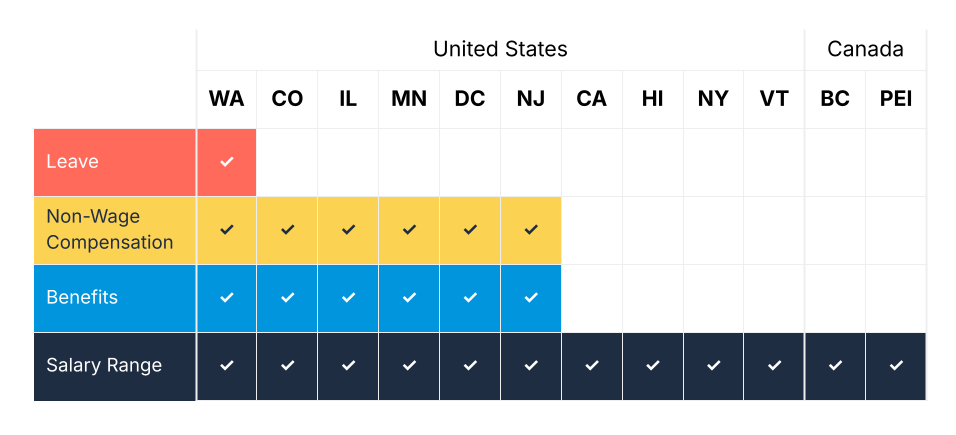Pay transparency has quickly moved from a best practice to a common legal requirement. Across the U.S. and beyond, legislation requiring employers to disclose salary ranges and benefits in job posts is rapidly evolving. Talent teams now face increasing pressure to ensure every job post is clear, compliant, and equitable as defined by local and regional standards that are not consistent.
But staying compliant with these shifting regulations isn’t easy, especially when requirements differ by state, city, and region. This complexity is precisely why Datapeople is stepping in to remove the burden of hiring compliance, helping hiring teams reduce the guesswork and confidently deliver a high-performance hiring process.
Here’s what you need to know about pay transparency in 2025, and how Datapeople helps you embrace with ease.
What’s changing in pay transparency?
Pay transparency laws are designed to reduce pay disparities, improve workplace equity, and ensure candidates have clear visibility into the compensation and benefits associated with any role. However, the patchwork of laws across the U.S. and other countries makes it difficult for talent teams to be consistently compliant. As we break down in our Guidance for New Pay Transparency laws, compliance is a moving needle to which hiring teams must adapt.
Key Pay Transparency Trends
- Wider geographic coverage: More states, municipalities, and cities are enacting pay transparency laws, including required disclosure of benefits in addition to salary ranges
- More detailed disclosure requirements: Several jurisdictions, like Washington State, now require job posts to disclose not just base salary but also benefits like health care, paid time off, and any bonuses or equity
- Stronger enforcement: States are becoming more proactive in enforcing compliance, issuing fines, or requiring job posts to be corrected after being flagged
Failing to comply with these new laws doesn’t just mean potential fines. It also risks damaging your employer brand by signaling a lack of transparency to candidates (and regulators).

The elevation of benefits requirements
Benefits can be a broad term, however in most US states they consist of three essential components: health care, retirement, and paid time off. While each state’s requirements may deviate slightly, starting with these as a standard is a good place to begin.
To address benefits requirements, that are increasingly required in many states and territories, Datapeople mandates references to health care, retirement, and paid time off benefits. Benefits descriptions do not need to be lengthy to be compliant. Washington State, known for its comprehensive requirements for pay transparency, has provided an example benefits blurb:
What we offer you:
- Medical, dental, vision, and basic life insurance coverage.
- 12 days of PTO a calendar year in addition to 12 paid holidays.
- Enrollment in our company’s 401k plan (with match).
- Potential to purchase company stock, receive annual bonuses, and participate in a deferred compensation plan.
Why talent teams should care?
Transparency in job posts isn’t just about legal compliance, it is increasingly important to candidates, securing trust and elevating the candidate experience to attract high-quality, diverse talent.
Data shows that job posts with clear pay and benefits information tend to:
- Attract higher-quality applicants
- Reduce application drop-off rates
- Promote more equitable and inclusive hiring processes
However, the burden of ensuring job post compliance has historically fallen on Talent Acquisition teams. This burden, solved most often by implementing a pre-publish checklist or manual job monitoring has led to elongated publishing timelines and a scramble to make required post-publishing edits. This burden is exactly why Datapeople designed our platform to make compliance easier and faster.
How Datapeople simplifies pay transparency
Datapeople takes the complexity out of pay transparency by ensuring every job post aligns with the latest regulations—without requiring manual oversight from your team.

Here’s how:
1. Automatic pay transparency alerts
Our Smart Editor proactively alerts your team if a job post is missing required pay or benefits information based on the job’s location. If your role is posted in California, for example, Datapeople will flag the need to include salary ranges and material benefits. This eliminates guesswork and protects you from accidental non-compliance.
2. Location-based guidance
Pay transparency laws vary widely by state, city, and region. Datapeople automatically applies location-specific guidelines to your job post content, ensuring you only include the information legally required for that job’s geography. This reduces the need for teams to constantly research shifting regulations.
3. Job board requirements-approved
Alongside states and municipalities, job boards decided they would also require pay transparency. However, what may satisfy regulators may not be aligned with job board formatting requirements. And if you’re not aligned with their format, your job may end up in job board jail. Datapeople makes it effortless to address both regulator and job board requirements when writing the job ad. Further, the compliance report in Datapeople Insights highlights where jobs may not align with requirements.
4. Standardized, clear language
Transparency is about more than just listing numbers—it’s about clear, compelling communication. Datapeople also evaluates your job content for readability, inclusivity, and clarity, ensuring that your pay and benefits disclosures resonate with job seekers. And when job boards begin requiring pay
5. Compliance without the overhead
The best part? You don’t need to overhaul your existing processes or workflows. Datapeople integrates seamlessly with major ATS platforms, so you can instantly improve content effectiveness compliance alignment without slowing down hiring.
What You Need to Include in Your Job Posts (By Law)
To give you a sense of what’s changing, here’s a quick snapshot of the minimum information now required in several major jurisdictions:
| Locale | Benefits |
| Colorado Act EPT Rules | A general description of all employment benefits the employer is offering for the position, including health care benefits, retirement benefits, any benefits permitting paid days off (including sick leave, parental leave, and paid time off or vacation benefits), and any other benefits that must be reported for federal tax purposes, but not benefits in the form of minor perks;A general description of any bonuses, commissions, or other forms of compensation that are being offered for the job; |
| Illinois Act Clarifying FAQs | The Department intends to provide more guidance and examples in the coming months. For now, employers are encouraged to consider all possible benefits.While an employer must describe at least the nature of the benefits and what they provide, they do not need to provide specific details, terms and conditions, or dollar values. |
| Minnesota Act Amendment | A general description of all of the benefits and other compensation, including but not limited to any health or retirement benefits |
| New Jersey Act | A general description of benefits and other compensation programs for which the employee would be eligible. Each failure to include the information required in this subsection in a particular job posting shall constitute a separate violation of this subsection. |
| Washington DC Act Amendment | Disclose to prospective employees the existence of healthcare benefits that employees may receive. |
| Washington Act DLI Guidance | A “general description of all benefits” includes, but is not limited to, health care benefits, retirement benefits, any benefits permitting paid days off (including more generous paid sick leave accruals, parental leave, and paid time off or vacation benefits), and any other benefits that must be reported for federal tax purposes, such as fringe benefits. Insurance: If an employer includes various types of insurance as part of the benefits package, the employer should list out the types of insurance in the job posting, such as medical insurance, vision insurance, dental insurance, life insurance, and disability insurance. Retirement Plans: If an employer includes various types of retirement options as part of the benefits package, the employer should list the retirement option in the job posting, such as 401k, employer-funded retirement plans, deferred compensation, and other defined benefit or defined contribution plans. Paid Time Off or Vacation: If the employer includes paid time off or paid vacation time as part of the benefits package, the employer should list the amount of days or hours the hired applicant would expect to receive, such as 8 hours per month or 12 days per year. Paid Holidays: If the employer includes paid holidays as part of the benefits package, the employer should list the number of paid holidays the hired applicant would expect to receive in the job posting, such as 10 paid holidays per year. The employer does not have to list each paid holiday. Other Compensation includes, but is not limited to, bonuses, commissions, profit-sharing, stock options, or other forms of compensation that would be offered to the hired applicant in addition to their established salary range or wage scale. |
This evolving landscape means Talent Leaders can no longer afford to overlook pay transparency—or delay adapting to new regulations.
The cost of non-compliance
The consequences of non-compliance extend beyond potential fines. Companies that fail to disclose pay and benefits risk:
- Damaging your employer brand. Job seekers notice when a company doesn’t share clear salary and benefits information—and it impacts their willingness to apply. Learn more about how to optimize your employer brand by reviewing our Ultimate Guide to Employer Brand.
- Excluding diverse talent. Pay transparency, including benefits, is a powerful driver of equitable hiring. Opaque pay practices disproportionately impact underrepresented groups, hindering diversity efforts. As we share in this blog post, candidates expect benefits.
- Wasted time and resources. Every time a job post gets flagged or rejected, it costs your team time and slows down hiring. Further, it may prevent your job from receiving the attention it deserves from job boards.
That’s why Datapeople is designed to make compliance fast, easy, and automatic. Increasingly, companies that prioritize transparency and compliance secure target talent effectively and efficiently. So join them effortlessly, with Datapeople.
Hungry for more pay transparency-related content?
